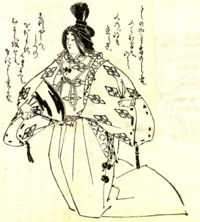Shizuka Gozen

Shizuka Gozen[1] (静御前) (1165–1211), or Lady Shizuka, one of the most famous women in Japanese history and literature, was a shirabyōshi (court dancer) of the 12th century, and a mistress of Minamoto no Yoshitsune. Since she, like many others, are featured largely in the Heike Monogatari (Tale of Heike), Gikeiki (Chronicle of Yoshitsune), and a number of plays of various traditions, her story is quite well known, but it is difficult to separate fact from fiction within it.
Early life
Her mother, Iso no Zenji, was a shirabyōshi as well. According to the Gikeiki, Shizuka was invited at one point by Retired Emperor Go-Shirakawa, along with 99 other dancers, to dance for rain after the chanting of 100 Buddhist monks failed to bring that same result. Though the 99 dancers likewise failed to bring rain, Shizuka's arrival brought the desired effect. She was then praised by the Emperor, and it was at this time that she met Yoshitsune.
When Yoshitsune fled Kyoto in 1185, after the end of the Genpei War, and following a disagreement with his brother, Yoritomo, the first Kamakura shogun, Shizuka was left behind in Yoshino. The exact details of how far she traveled with Yoshitsune before being sent back, or whether she traveled further than Yoshino at all, differ from one literary work to the next, as do many of the other finer details of her tale. In any case, she was captured by Hōjō Tokimasa and forces loyal to Yoritomo, and, according to some versions of the story, forced to dance for the new shogun at Tsurugaoka Hachiman-gū. There, she sang songs of her longing for Yoshitsune, which angered Yoritomo; but Yoritomo's wife Hōjō Masako was sympathetic, and helped to have her released. However, she was by this point pregnant with Yoshitsune's child; Yoritomo declared that if it were a daughter she could live on peacefully, but if it were a son, he would have the child killed. A short time later, when Shizuka was 19, she gave birth to a son; Adachi Kiyotsune tried to take the child, who was instead given to Shizuka's mother. She then traveled back to Kyoto, where she became a Buddhist nun. Shizuka was later killed, however, along with her and Yoshitsune's child, by the order of Yoritomo.
According to some versions of the story, she did not become a nun upon her return, nor was she killed. Alternatively, she returned to Kyoto and was welcomed by Hōjō Masako back into court life, where she remained for a time. She then left the capital once more, committing suicide by drowning herself in a river, though versions differ on where this occurred.
Commemoration
Shizuka features prominently in the Noh play Funa Benkei and the bunraku play Yoshitsune Senbon Zakura, both of which were later adapted by kabuki, and in a number of other works of literature and drama, both traditional and modern. She is also celebrated throughout the country in various festivals; many towns across Japan claim to be the location for her religious exile, her death, or other significant events of her life.
In popular culture
Shizuka is represented in the 2005 video game Genji: Dawn of the Samurai, as "Gozen Shizuka" (Lady Shizuka), a character who aids the protagonist, Yoshitsune Minamoto and his ally (a former enemy) Saito Musashibo Benkei during the course of the game. Gozen Shizuka is depicted as an exceptionally beautiful young woman with long silver hair. She is the survivor who possesses the power of Yosegane, and she returns in the 2006 PlayStation 3 sequel, Genji: Days of the Blade as one of playable characters, where she is depicted similarly.
See also
| Wikimedia Commons has media related to Shizuka Gozen. |
Notes
- ↑ Note: Gozen is not a name, but rather an honorific title, usually translated to "Lady", though the title was rarely bestowed upon men as well.
References
- Some of this article is derived from the corresponding article on the Japanese Wikipedia.
- Frederic, Louis (2002). "Japan Encyclopedia." Cambridge, Massachusetts: Harvard University Press.
- Jones, Stanleigh H. Jr. (trans.)(1993). "Yoshitsune and the Thousand Cherry Trees." New York: Columbia University Press.
- McCullough, Helen Craig (trans.)(1988). "The Tale of the Heike." Stanford, California: Stanford University Press.